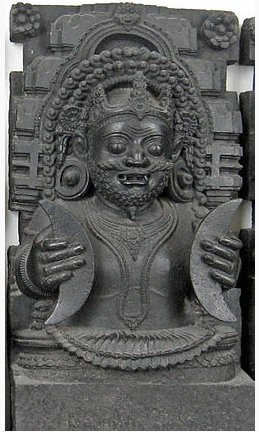Life necessitates death and after the disappearance of the old generation follows the new which is basically the same: ... And then the bone spoke; it was there in the fork of the tree: Why do you want a mere bone, a round thing in the branches of a tree? said the head of One Hunaphu when it spoke to the maiden. You don't want it, she was told. I do want it, said the maiden. Very well. Stretch out your right hand here, so I can see it, said the bone. Yes, said the maiden. She stretched out her right hand, up there in front of the bone. And then the bone spit out its saliva, which landed squarely in the hand of the maiden. And then she looked in her hand, she inspected it right away, but the bone's saliva wasn't in her hand. It is just a sign I have given you, my saliva, my spittle. This, my head, has nothing on it - just bone, nothing of meat. It's just the same with the head of a great lord: it's just the flesh that makes his face look good. And when he dies, people get frightened by his bones. After that, his son is like his saliva, his spittle, in his being, whether it be the son of a lord or the son of a craftsman, an orator. The father does not disappear, but goes on being fulfilled. Neither dimmed nor destroyed is the face of a lord, a warrior, craftsman, an orator. Rather, he will leave his daughters and sons ...
... In Hindu tradition, Rahu is a cut-off head of an asura, that swallows the sun or the moon causing eclipses. He is depicted in art as a serpent with no body riding a chariot drawn by eight [8] black horses ... According to legend, during the Samudra manthan, the asura Rahu drank some of the divine nectar. Sun and moon realized it and they alerted Mohini (the female avatar of Vishnu). Before the nectar could pass his throat, Mohini cut off his head. The head, however, remained immortal. It is believed that this immortal head occasionally swallows the sun or the moon, causing eclipses. Then, the sun or moon passes through the opening at the neck, ending the eclipse ...
The central glyph in the 'eclipse sequence' (Ga1-17) has a maro (feather) string hanging down, a sign which should mean a border mark ('finish line'). In 1582 A.D. the nakshatra point at the Full Moon was 260 (= 1842 - 1582) days after ºMarch 21 (= ºDecember 6). ... There is an account of the star from the Khitan Liao Dynasty, which ruled in the area around Manchuria from 907–1125. The book in question, the Qidan Guozhi, was compiled by Ye Longli in 1247. It includes various astronomical notes, some of which are clearly copied from the Song Shi. This entry referring to the star of 1054 seems unique: Chongxi era of the reign of [King Xingzong], twenty-third year eighth [8] lunar moon, the ruler of the realm is dead. It happened before a solar eclipse at noon, and a guest star [the nova SN1054 - which was observed in the year 1054 A.D. and then evolved into the Crab Nebula] appeared. The highest office at the Office of History, Liu Yishou had said 'These are omens of the death of the King.' This prediction has been realized ... Early in my efforts to try to understand what the glyphs depicted I imagined Ga1-18 looked like a crab. Now, after having discovered the place of the nova SN1054 (nowadays of course quite invisible) which evolved to the Crab Nebula (visibility only 8.4), I guess the creator of the G text alluded to the resemblance between a death skull and a crab - both with 'exosceletons'. The empty eye-socket in front ought to mean 'not visible'.
| ||||||||||||||||||||||||||||||||||||||||||||||||||||||||||||||||||||||



